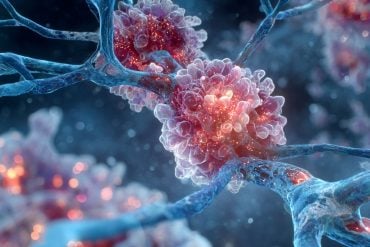Summary: Researchers have identified two new species of bacteria in the blood of patients in China. The bacterias are in the Enterobacter genus and are resistant to multiple antibiotics. Enterobacter has previously been linked to meningitis and other serious medical conditions.
Source: Microbiology Society.
Two new species of bacteria have been found in the blood of patients in China.
The bacteria were found in the blood of two human patients during blood tests as part of routine medical care. The new bacteria, both of which are in the Enterobacter genus, were found to be resistant to multiple antibiotics.
Enterobacter are not usually harmful and exist as part of the healthy gut microflora. However, when these bacteria enter the bloodstream, respiratory system or the urinary tract they can cause disease.
Enterobacter infection in the blood canlead to diseases including meningitis and bacteraemia, and Enterobacterin the lungs can lead to pneumonia. Bacteraemia is the presence of bacteria in the bloodstream and can lead to serious conditions including sepsis and septic shock.
The researchers named the newly discovered species Enterobacter huaxiensis and Enterobacter chuandaensis.The bacteria were named after the region in which they were discovered and Sichuan University, where the authors are based.
The discovery of E. huaxiensis and E. chuandaensiswas reported in the International Journal of Systematic and Evolutionary Microbiology, along with a description of the new species and their antimicrobial resistance profiles.

The resistance of these newly discovered bacteria to antibiotics is a concern, as this would make the treatment of life-threatening infections more difficult. Both new species are resistant to penicillin and cephalosporin group antibiotics. These antibiotic groups are commonly used to treat bacterial infections.
Bacterial infections such as bacteraemia are usually with frontline antibiotics and a delay in treatment could cause progression to sepsis. Sepsis has a high mortality rate and so it is vital this condition is treated quickly.
Source: Microbiology Society
Publisher: Organized by NeuroscienceNews.com.
Image Source: NeuroscienceNews.com image is adapted from the Microbiology Society news release.
Original Research: Abstract for “Enterobacter huaxiensis sp. nov. and Enterobacter chuandaensis sp. nov., recovered from human blood” by Wenjing Wu, Li Wei, Yu Feng, Mei Kang, and Zhiyong Zong in International Journal of Systematic and Evolutionary Microbiology. Published January 7 2019.
doi:10.1099/ijsem.0.003207
[cbtabs][cbtab title=”MLA”]Microbiology Society “New Bacteria Discovered in Human Blood.” NeuroscienceNews. NeuroscienceNews, 10 January 2019.
<https://neurosciencenews.com/new-blood-bacteria-10491/>.[/cbtab][cbtab title=”APA”]Microbiology Society(2019, January 10). New Bacteria Discovered in Human Blood. NeuroscienceNews. Retrieved January 10, 2019 from https://neurosciencenews.com/new-blood-bacteria-10491/[/cbtab][cbtab title=”Chicago”]Microbiology Society “New Bacteria Discovered in Human Blood.” https://neurosciencenews.com/new-blood-bacteria-10491/ (accessed January 10, 2019).[/cbtab][/cbtabs]
Abstract
Enterobacter huaxiensis sp. nov. and Enterobacter chuandaensis sp. nov., recovered from human blood
Enterobacter strains 090008T and 090028T were recovered from the blood of two different patients at West China Hospital, Chengdu, PR China in 2017. Phylogenetic analysis based on the 16S rRNA gene and multi-locus sequence analysis of the rpoB, gyrB, infB and atpD housekeeping genes revealed that the two strains were distinct from any previously known species of the genus Enterobacter . Both average nucleotide identity (ANI) and in silico DNA–DNA hybridization (isDDH) values between strains 090008T, 090028T and type strains of all known Enterobacter species were lower than the cut-off (≥95–96 % for ANI and ≥70 % for isDDH) to define a bacterial species. The major cellular fatty acids of strains 090008T and 090028T are C16 : 0, C17 : 0cyclo and C18 : 1ω7c, which are similar to other Enterobacter species, and the genomic DNA G+C content was 55.73 and 55.68 mol%, respectively. Strain 090008T can be differentiated from other Enterobacter species by its ability to ferment sucrose, melibiose and d-arabitol, but with a negative methyl α-d-mannopyranoside reaction. Strain 090028T can ferment potassium gluconate, but is negative for l-fucose, mdecarboxylase, deaminase aelibiose and d-sorbitol, which distinguishes it from all other Enterobacter species. Genotypic and phenotypic characteristics indicate that strains 090008T and 090028T represent two novel species of the genus Enterobacter , for which the names Enterobacter huaxiensis sp. nov. and Enterobacter chuandaensis sp. nov. are proposed, respectively. The type strain of Enterobacter huaxiensis sp. nov. is 090008T (=GDMCC1.1426T=CCTCC AB 2018174T=CNCTC 7648T) and the type strain of Enterobacter chuandaensis sp. nov. is 090028T (=GDMCC1.1427T=CCTCC AB 2018173T=CNCTC 7649T).






